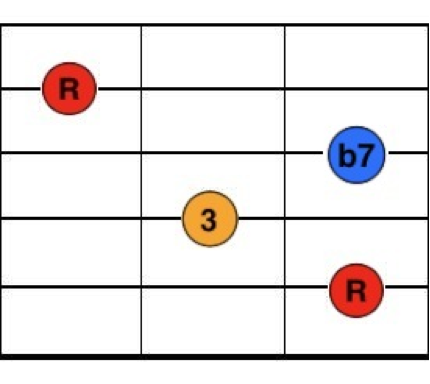Guitar Jam Mini Course Lesson 3:
Everything You Need To Know About Using Blues Chords In a Jam Session
Welcome back for part 3 of this ‘How How To Play At a Blues Guitar Jam’ Mini Course. In this lesson we’ll look at minor blues chords, seventh chords and turnarounds. These are all considered ‘basic vocabulary’ when you want to play at a blues jam. So let’s dive right in!
Minor Blues Progressions
You can divide blues progressions in two large groups; on one side we have the dominant blues chord progression which we explained with the E7 example in the previous lesson and on the other side we have the minor blues chord progression (short: minor blues). A minor blues can typically be recognized by a laid-back style of playing and the soulful playfulness that comes with it.
When playing a minor blues, we are playing all minor seventh chords. For instance, if we are playing a minor blues in the key of E and the jam session leader is shouting at you that you need to play a minor blues in the key of E; instead of using the E7, A7, and B7 chord as in the dominant blues example, you would be playing the E minor 7, the A minor 7 and the B minor 7 chords here (short: Em7, Am7 and Bm7). Listen to the next examples on this page where I am playing a dominant blues in the key of E and then a minor blues in the key of E minor.
Listen to a blues in the key of E
Listen to a minor blues in the key of E (minor)
The first example is a dominant blues progression in the key of E7. In the second example I am playing a minor blues in the key of E minor. Listen to the change in feeling between those two groups of blues progressions. You will notice that the minor one has a more sad bluesy type of feel to it, while the dominant progression has a happier feel.
The Seventh Chord
Another term that is being used a lot by blues musicians is the seventh chord (short: 7th chord). The seventh chord is being used all over the blues. We previously looked at seven chords in the E7 dominant blues progression. While it is not my intention in this article particularly to look at how to play these rhythm parts (we will be covering this in the next emails in this mini-course), it is very important that you know what the seventh chord is.
The seventh chord is basically a chord which has four notes in it; it contains the ‘root’ of the chord, the ‘third’ of the chord, the ‘fifth’ of the chord and the ‘seventh’ of the chord. There are different types of seventh chords, but when not otherwise specified, a "seventh chord" usually implies a dominant seventh chord.
In the chord diagram below you see the E7 chord with the root note located at the 7th fret on the A string. I color coded the pitches in the chord;
Root note = red (in the case of the E7 chord, the root note is the E note)
The third = yellow (in this case the G# note)
The fifth = not present here (the fifth can be left out of chords, which is the case with this E7 chord here)
The flat seven = blue (in this case the D note)

5 7
E7
The dominant seventh chord really has an important role in blues music because it comes with the well-known tormented bluesy feel. You can play this chord in all kinds of dominant blues songs. As stated above, the point of this lesson is not that you use this chord (at least for now), but you will need it in the coming lessons.
The Turnaround
Another term that is being used to communicate often during a jam session is “the turnaround”. When you are jamming you might hear someone call out this phrase “go to the turnaround”. The turnaround in blues is something particularly when you are playing a blues progression. This turnaround is typically located at the end of the progression and is often highlighted with some sort of turnaround lick. We will be covering the turnaround more in depth with some examples in one of the coming lessons in this mini course.
But for now it is important to know that in the key of E7, when you’re playing a dominant blues progression, the turnaround would be the last chord when we go back to the B7 chord. It is really common to go back to the B7 chord when you are playing a dominant blues in the key of E during the last bar and we call this the turnaround.
Listen to the next sound examples; in the first example I play a 12 bar blues progression in the key of E without adding a turnaround at the end. In the next example I’m playing the same 12 bar, but now I’m adding the B7 chord.
Listen to the twelve bar played WITHOUT turnaround
Listen to the twelve bar played WITH turnaround
This is also communicated sometimes by using the term “go to the five chord”. When you say, “go to the five chord”, we mean go to the turnaround, or if the five chord is located in another bar of the progression, it would be the B7 chord when we are playing in the key of E7. It’s important to realize that everything is related to the key. The five chord in the key of E is the B7 chord, because the B7 chord is the fifth chord in the key of E. But when we are playing in A7 for instance, then the five chord would be the E7 chord, since it’s the fifth chord of that key.
While all of this may sound confusing to you right now, it’s important to realize that your understanding of this is related to your current level of knowledge on the topic of blues music theory. So if there are things that you don’t get from reading all this, then it may or may not be the best time to learn about this.
What I mean with this is that if your current understanding of some of these topics is not on the level that’s necessary to understand this article fully, trying to read it over and over again is not going to help you. What you need is immersion into these topics by being exposed to these issues over and over, with different examples and implementation exercises.
Learn about the Essential Blues Guitar Soloing Lesson
